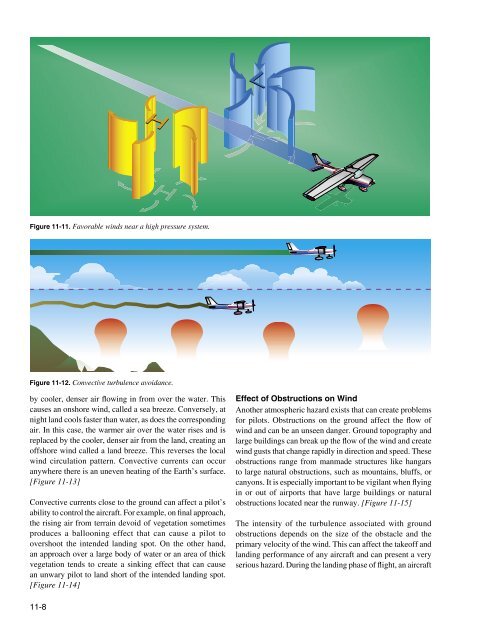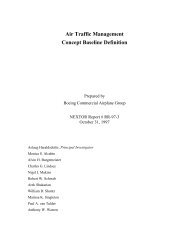Chapter 11: Weather Theory - FAA
Chapter 11: Weather Theory - FAA
Chapter 11: Weather Theory - FAA
You also want an ePaper? Increase the reach of your titles
YUMPU automatically turns print PDFs into web optimized ePapers that Google loves.
Figure <strong>11</strong>-<strong>11</strong>. Favorable winds near a high pressure system.Figure <strong>11</strong>-12. Convective turbulence avoidance.by cooler, denser air flowing in from over the water. Thiscauses an onshore wind, called a sea breeze. Conversely, atnight land cools faster than water, as does the correspondingair. In this case, the warmer air over the water rises and isreplaced by the cooler, denser air from the land, creating anoffshore wind called a land breeze. This reverses the localwind circulation pattern. Convective currents can occuranywhere there is an uneven heating of the Earth’s surface.[Figure <strong>11</strong>-13]Convective currents close to the ground can affect a pilot’sability to control the aircraft. For example, on final approach,the rising air from terrain devoid of vegetation sometimesproduces a ballooning effect that can cause a pilot toovershoot the intended landing spot. On the other hand,an approach over a large body of water or an area of thickvegetation tends to create a sinking effect that can causean unwary pilot to land short of the intended landing spot.[Figure <strong>11</strong>-14]Effect of Obstructions on WindAnother atmospheric hazard exists that can create problemsfor pilots. Obstructions on the ground affect the flow ofwind and can be an unseen danger. Ground topography andlarge buildings can break up the flow of the wind and createwind gusts that change rapidly in direction and speed. Theseobstructions range from manmade structures like hangarsto large natural obstructions, such as mountains, bluffs, orcanyons. It is especially important to be vigilant when flyingin or out of airports that have large buildings or naturalobstructions located near the runway. [Figure <strong>11</strong>-15]The intensity of the turbulence associated with groundobstructions depends on the size of the obstacle and theprimary velocity of the wind. This can affect the takeoff andlanding performance of any aircraft and can present a veryserious hazard. During the landing phase of flight, an aircraft<strong>11</strong>-8
















